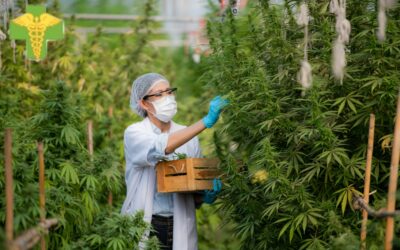How terpenes interact with medical marijuana
What Are Terpenes?
You return home after getting your medical marijuana, and you open your bag. Suddenly, you are surrounded by a very potent, yet familiar smell. But what exactly is that smell, and why does it make your marijuana so aromatic? The answer lies in one of the lesser-known chemical compounds in cannabis: terpenes.
Terpenes are all around us and naturally occur in nature. Often found in plants and animals, terpenes give us some of our favorite scents and flavors. In this post, we will discuss the role terpenes have in cannabis and the effects they can have on your health.
Cannabis Terpenes
Terpenes are the chemical compounds that give cannabis its distinctive smell and flavor. Cannabis plants produce over 100 different types of terpenes – some more common than others. Each individual terpene has its own medical benefits and influence on cannabis.
Like other plants with terpenes, cannabis secretes terpenes to repel predators and attract pollinators. Cannabis plants will produce various terpenes depending on their environment and cultivation.
Here are some commonly known terpenes are their health benefits:
- Pinene: an antibacterial, anti-inflammatory that smells like pine
- Linalool: a sedative, analgesic that smells like lavender
- Phellandrene: a peppermint scented terpene with antidepressant properties
- Phytol: an anti-anxiety terpene that smells like balsamic
- Limonene: a citrus scented terpene that helps you focus
- Beta-caryophyllene: a clove and rosemary scented terpene beneficial for anxiety
Terpenes are a vital compound that work in connection with the various cannabinoids produced by cannabis plants. Currently, scientists are searching for a way to use terpenes as a classification system for marijuana. Researchers hope to one day easily predict the effects of certain strains of cannabis by breaking down terpene in certain profiles.
Although terpenes themselves will not create a euphoric effect, scientists hypothesize that dominant terpenes can affect the way certain cannabis strands are developed. By working with the individual cannabinoids in cannabis, terpenes hypothetically work together to create different effects and strains.
How Do Terpenes Differ From Cannabinoids?
Although terpenes and cannabinoids are both chemical compounds found in cannabis, they both serve very different purposes. Cannabinoids such as CBD and THC interact with our body’s endocannabinoid system and activate the different receptors found throughout our body.
THC, the most commonly known cannabinoid, is responsible for making people feel “high” and is classified as a psychoactive component. CBD does not make us feel high, but it still interacts with our body’s receptors.
Terpenes are mostly responsible for smell and have a different effect on our body. Although some terpenes can affect our endocannabinoid system, it mostly impacts our senses.
Will Terpenes Make Me High?
Terpenes, whether from cannabis or any other plant, will not get you high. Although they have many beneficial effects, only some terpenes are psychoactive.
However, research suggests that they can affect your mood. A 2013 study on the citrus terpene, limonene, showed a significant antidepressant effect on rodents during experiments.
A 2001 review about terpenes suggests that they may even increase dopamine and serotonin while combined with the effects cannabis. By working with the effects of THC, terpenes can impact the high feeling that you get from medical marijuana. In a recent 2020 study, preliminary research suggests that the special effects of terpenes combined with cannabinoids may be used for the treatment of certain mood and anxiety disorders.
Further research also shows that smell can have a negative or positive effect on your cannabis experience.
The Entourage Effect
Terpenes are secreted through the cannabis plant’s resin glands along with its cannabinoids. With over 100 different terpenes and cannabinoids, each combination works differently and creates a unique strand and effect. This compound synchronicity is commonly referred to as “the entourage effect.”
With all the cannabinoids and terpenes working together, each compound creates its own distinctive effect that enhances each strain of cannabis. As research into cannabis progresses, scientists are beginning to discover that terpenes and other lesser-known cannabinoids may have their own benefits.
Terpenes, in union with the other naturally occurring compounds in cannabis work together to strengthen each compound’s beneficial effects.
How Do Terpenes Develop?
As terpenes become more important to cannabis consumers, cultivators are discovering new and creative ways to enrich each terpene’s profile and outcome. Currently, we are aware of several different factors that an effect your cannabis’ flavors and benefits.
Environment
The region where a cannabis plant is grown can have a great effect on the terpene profile that it develops. These environmental factors include how the plant is grown (soil or hydroponic), the amount of light, and whether the plant is grown inside or outside.
Pruning and Maintenance
When cannabis plants are properly trimmed and maintained, they produce stronger buds with higher levels of terpenes. If the excess, less bountiful parts of a cannabis plant are trimmed, the plant will automatically redirect its energy to its trichomes.
Once a plant is ready to be harvested, it should be properly cured in ideal conditions. By keeping plants in the dark and properly cured, terpenes will remain strong and substantial.
What Else Are Terpenes Used For?
Since terpenes have such a strong smell, they are often used for essential oils. For many years, people have used terpenes for health and wellness. Many people believe that inhaling terpenes can alter their mood and even alleviate their stress levels.
Recently, scientists have started researching the effects that isolated terpenes have on people. When studying the terpene limonene, scientists discovered that it was anti-inflammatory, antiviral, and antioxidant. Several other health benefits were also discovered.
For years, terpenes have also been used in various cleaning products and fragrances. Citrus terpenes have been highly regarding for years for their ability to effectively clean products and surfaces without corrosion or rust.
Conclusion
Without even knowing it, terpenes have had a significant impact on our lives. As we await future cannabis and terpene research, one area of research to keep an eye out for is the entourage effect. By learning about how terpenes interact with medical marijuana, we can further progress the field and strain development.
Sources:
https://www.healthline.com/health/cannabis-terpenes?c=1100843989265#do-they-make-you-high
https://www.ncbi.nlm.nih.gov/pmc/articles/PMC7324885/
https://www.leafly.com/news/cannabis-101/terpenes-the-flavors-of-cannabis-aromatherapy
https://www.encore-labs.com/terpene-identification
https://www.risingleaffarms.com/terpenes
https://www.medicalnewstoday.com/articles/what-are-terpenes#terpenes-vs-cannabinoids
https://www.leafly.com/news/growing/how-to-increase-cannabis-terpenes-when-growing
https://cannador.com/articles/single/do-terpenes-get-you-high







